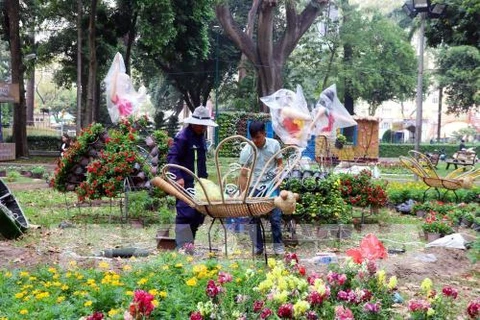 A calligrapher writes Vietnamese script at a traditional calligraphy market at the Temple of Literature. (Photo thethaovanhoa.vn)
A calligrapher writes Vietnamese script at a traditional calligraphy market at the Temple of Literature. (Photo thethaovanhoa.vn) Hanoi (VNS/VNA) - Easy to read and understand, Vietnamese calligraphy is a lot simpler to understand than the Han Chinese version, which helped boost its popularity during Tet (Lunar New Year) holiday.
The tradition of collecting letters has become part of Vietnamese culture whenever Lunar New Year arrives. The calligraphic works, which can be romanised Vietnamese, Han Chinese or Nom (Vietnamese ideographic) scripts written by elderly scholars, expresses the Vietnamese people’s respect for knowledge.
The scripts are written on traditional do (poohnah) paper and become symbols of good fortune.
Many calligraphers who are able to write both Vietnamese and Han-Nom calligraphy received increasing orders for Vietnamese calligraphy this year.
“Eighty percent of my customers ask me to write them romanised Vietnamese scripts,” said Hoang Dinh Truong in an interview with Thanh Nien newspaper.
According to Truong, who works at the Temple of Literature and Hai Ba Trung Temple in Hanoi, he was often asked to write the word An in Vietnamese, which means peace.
However, his customers have recently requested other meaningful words, depending on their wishes.
“Most of them prefer Vietnamese calligraphy as it is easier to read and understand. They want it to be readable. Ancient Han-Nom scripts have been largely forgotten so most people can't read them," he said.
“I think both are fine, so it's only important to preserve the tradition, and educating the younger generations about a respect for learning and knowledge,” he added.
Tran Hau Yen The from Vietnam University of Fine Arts also agreed that romanised Vietnamese calligraphy had become increasingly popular.
Vietnamese calligrapher Kieu Quoc Khanh added that other calligraphers specialising in the modern national script had adapted the sophisticated writing techniques for Han-Nôm scripts to enrich their writing styles.
Parallel developing
However, according to Pham Van Tuan from the Institute of Han-Nom Studies, more people ask for ancient Han-Nom scripts at the Temple of Literature, which gathers renowned calligraphers in Hanoi.
“The Temple of Literature is a space dedicated to Confucianism and traditional culture. People they should ask for words related to examinations and traditions,” Tuan said.
“Romanised Vietnamese calligraphy is also asked for but not as much. Some people see others asking for Vietnamese scripts and do the same.”
“I hope that more Han-Nom classes will be organised for youngsters,” he said.
“The past ten years has seen the increasing development of writing Vietnamese with ink brushes. However, Vietnamese calligraphy has not yet achieved a standardised system like Han-Nom calligraphy."
However, he said there had been technical advances in romanised Vietnamese calligraphy.
“From the north, calligrapher Kieu Quoc Khanh has been accredited with bringing and introducing the system of Vietnamese calligraphy in the south. Therefore, Vietnamese calligraphy has never been as diverse as it is today. Frequently interacting with other artists, Khanh has come up with many innovations and influences on Vietnamese calligraphy,” he said.
Meanwhile, Tran Hau Yen The has also had many calligraphic creativiteness showcase artistic elements.
One of his works combined with contemporary art is being displayed at the National Assembly Building. Written in vertical lines, the words have shapes similar to Han and Nom scripts.
“At the beginning, I intended to write Han and Nom characters on the stele. However, after that, I changed my mind to make it easier for viewers to read and understand,” The said.
Pham Van Tuan agreed that the increasing favour of Vietnamese calligraphy was understandable.
However, the co-existence of two calligraphic styles were not mutually exclusive.
"I think they will grow in parallel," he said./.
VNA
























